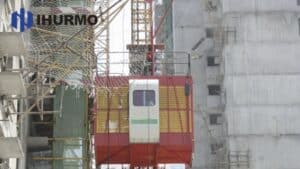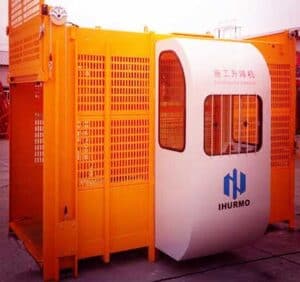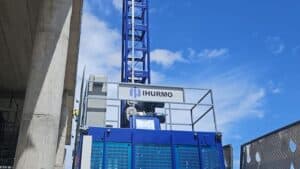What are Construction Lifts?
Construction lifts, also called aerial lifts or man lifts, are crucial machines that help workers reach high places and move materials or tools. Commonly, there are five main types of construction lifts, and each can be classified with different machines.
What are the Different Types of Lifts?
Boom Lifts

Boom lifts are versatile and can reach heights that other lifts cannot. These lifts have a long, extendable arm that can move in different directions to get you where you need to be. Boom lifts come in three main types: articulating, telescopic, and towable boom lifts.
Articulating boom lifts
The aerial platform device is equipped with a flexible arm with multiple joints and is mounted on a mechanical turntable. Often referred to as a “knuckle lift,” it can reach elevations ranging from 30 to 100 feet.
Since the base of the arm is connected to a rotating turntable, the articulating boom lift can rotate a full 360 degrees. The joints in the arm allow for movement in different directions, offering significant flexibility and accessibility to areas that are otherwise hard to reach.
Ideal for indoor applications and confined areas, this lift is designed to support a limited number of workers, making it ideal for tasks like maintenance and repairs.
Telescopic boom lifts
A telescopic or straight boom lift is characterized by a simpler arm structure that allows for vertical and horizontal movement. Commonly referred to as “stick booms” due to their elongated design, these lifts are ideal for tasks requiring extended reach, as their arms can extend over 100 feet.
These machines are primarily designed for outdoor projects and can accommodate one to two workers at a time. Although the platform (or bucket) is more compact and not intended for lifting heavy equipment, the significant length of the arm makes it perfect for specialized tasks that a small crew can handle.
Telescopic boom lifts are available in both gas-powered and electric-powered options, providing flexibility for different operational needs.
Towable boom lifts
Towable boom lifts feature a boom lift with the convenience of being towable by a standard vehicle, such as a pickup truck or SUV. They are equipped with a hydraulic arm that can extend horizontally and vertically, ending in a platform or bucket from which workers can operate.
This design allows them to be used for various tasks, such as working on telephone, cable, and power lines, as well as installing holiday decorations and performing maintenance tasks.
Scissor Lifts

If you need a steady platform that can raise workers or equipment straight up, scissor lifts are likely what you’ll use. They are made of crisscrossing metal supports that extend upward, and they can handle various heights and weights. Scissor lifts are particularly useful for jobs that require a stable work area and are available for use indoors and outdoors.
Electric scissor lifts

Electric scissor lifts are powered by batteries and are well-suited for indoor applications, particularly in environments where minimal noise and zero emissions are required. Due to their compact design and smooth operation, they are commonly used in warehouses, retail spaces, and maintenance tasks.
These lifts offer a relatively high platform reach and stable lifting capacity without the need for fuel. Electric scissor lifts can be easily maneuvered in tight spaces, ensuring efficient transportation around sites with narrow aisles.

Rough terrain scissor lifts
The rough terrain scissor lift is built for rugged outdoor environments. These scissor lifts come equipped with tough tires, powerful engines (often diesel-powered or petrol-powered), and enhanced stability, making them ideal for construction sites, uneven ground, and outdoor maintenance tasks.
They have higher ground clearance and may feature four-wheel drive for improved traction. The platforms on these lifts often have larger capacities, allowing them to hold multiple workers and equipment at once.
Fixed scissor lifts
A fixed scissor lift is typically installed in one permanent location, such as in a factory, warehouse, or production facility. These lifts are used for lifting heavy goods or equipment between different levels and often serve as part of the infrastructure for assembly lines.
With a high load-bearing capacity, fixed scissor lifts are commonly used for repetitive lifting tasks and heavy-duty operations.
Truck-mounted scissor lifts
The truck-mounted scissor lift is affixed to a truck or van for mobile lifting tasks. Due to its mobility, it is widely used for road work, maintenance, or field operations where traveling between multiple locations is essential.
The scissor lift is mounted on the back of a vehicle, offering both the height and reach advantages of a lift with the convenience of easy transportation. These lifts are generally powered by the vehicle’s power source, providing flexibility for outdoor and on-the-go work.
Vertical Mast Lifts

A vertical mast lift is a specialized type of aerial lift designed for vertical access in tight or confined spaces. These lifts are compact and highly maneuverable, making them ideal for indoor applications where precise access to a specific height is required.
Unlike scissor lifts, which have larger platforms, vertical mast lifts typically have a smaller platform designed to hold only one worker. They are commonly used for tasks that demand quick and efficient access to high-reaching areas, such as lighting maintenance, shelving installation, electrical work, and general indoor facility repairs.
Self-Propelled Vertical Mast Lifts
These are electric-powered and offer enhanced mobility, as they are designed to be driven from one location to another without the need for manual transport. While the worker is on the platform, the lift can be moved to different spots without lowering it completely. This makes the operation smoother and time-efficient for tasks that need constant repositioning.
Push-Around Vertical Mast Lifts
These models are manually pushed into the desired position before being elevated. They are lightweight and designed to be easily transported by a single worker. Once they are in place, the workers on the platform may elevate themselves to the required height. Push-around masts are ideal for low-usage applications or where self-propelled capability is not required, offering an economical choice for quick jobs.
Forklifts

The forklift is used primarily for moving, lifting, and placing heavy loads over short distances. Equipped with two prongs or “forks” at the front, forklifts are designed to lift heavy objects—such as pallets of goods, crates, and containers—from the ground to varying heights.
Warehouse Forklifts
The counterbalance forklift is the most recognizable and widely used type of forklift. It features a weight at the rear of the machine to counterbalance the load carried at the front forks. This type is ideal for transporting loads in warehouses, factories, and storage facilities. Counterbalance forklifts can quickly move pallets to and from shelving units or trucks.
Telescopic Forklifts
A telescopic forklift is a hybrid between a forklift and a crane. It has a telescoping boom that can extend forward and upward, allowing it to reach places a standard forklift cannot. This makes it ideal for operations requiring extended reach in construction, agriculture, and logistics.
How to Choose the Right Lift for Construction Project?
When choosing a construction lift equipment, it can be confusing to decide which type is best for your job. While here are some factors you need to consider:
- Job Site Conditions:Determine whether the lift will be used indoors or outdoors.
- Type of Movement Required:Assess whether you need vertical or horizontal movement. Scissor lifts are suitable for vertical lifting, while boom lifts provide vertical and horizontal reach.
- Space and Access Constraints:Consider the available workspace and access points. Compact lifts are necessary for tight spaces, while larger lifts can be used in open areas.
- Weight Capacity:Evaluate the maximum load that needs to be lifted, including personnel and materials.
- Lift Height and Reach:Identify the maximum height and reach needed for your project.
- Terrain Conditions:Consider the terrain of your job site. Rough terrain lifts are designed for uneven surfaces, while standard models are suitable for flat surfaces.
Frequently Asked Questions
What is a cherry picker? Are they the same as boom lifts?
A cherry picker is an aerial lift platform consisting of a bucket or platform at the end of a hydraulic lifting system, typically mounted on a vehicle such as a truck. The hydraulic arm can extend and retract, allowing workers to reach high areas for maintenance, utility work, and construction.
Cherry pickers are indeed similar to boom lifts, as both are used to elevate workers and equipment to perform tasks at height. However, there are some distinctions.
What is spider lift? When should I choose to use it?
A spider lift is a type of mobile elevating work platform characterized by its lightweight and compact design, along with four stabilizer legs that provide stability and leveling. These lifts are versatile and capable of maneuvering in tight spaces, making them ideal for tasks in areas that are difficult to access
How does a boom lift differ from other aerial work platforms?
Boom lifts stand out because they have a telescopic or articulating arm that extends to various lengths and angles. This makes them perfect for reaching over obstacles or getting to high places that are not directly overhead, unlike scissor lifts that only move vertically.






